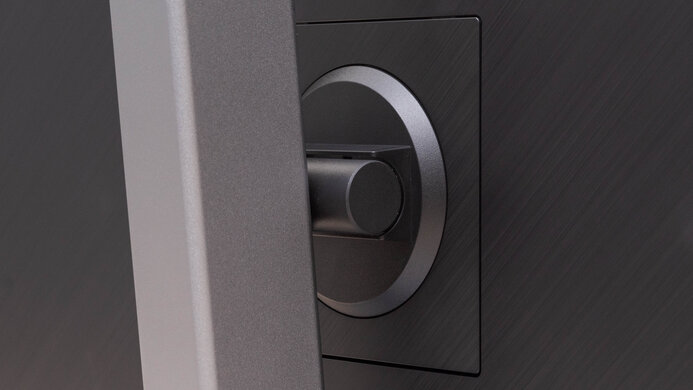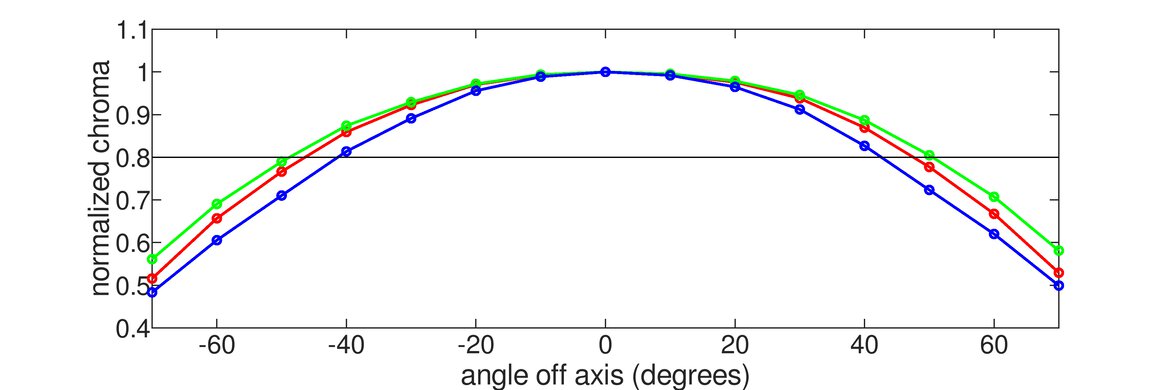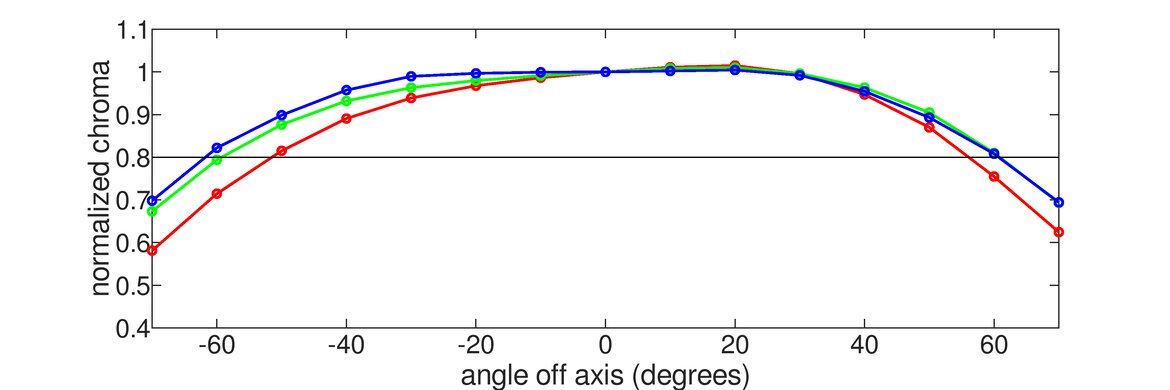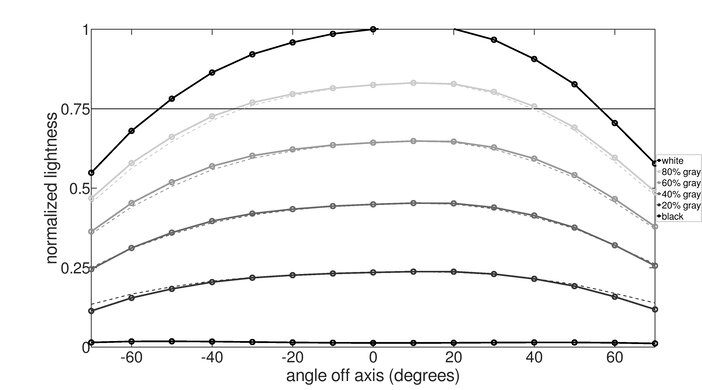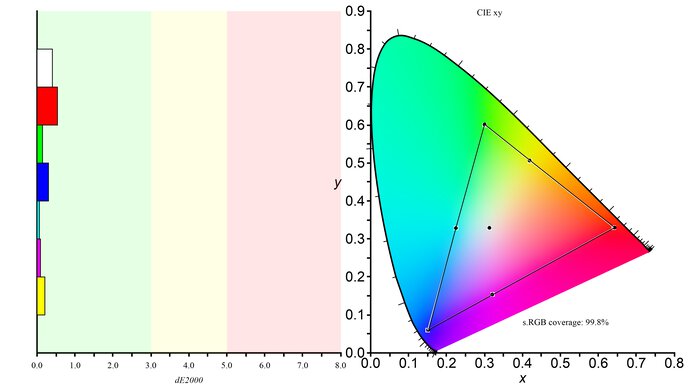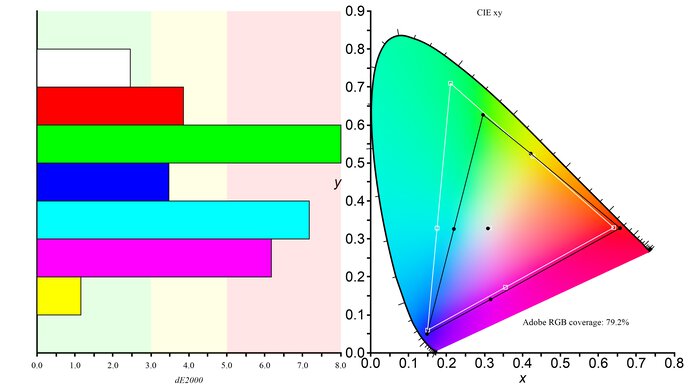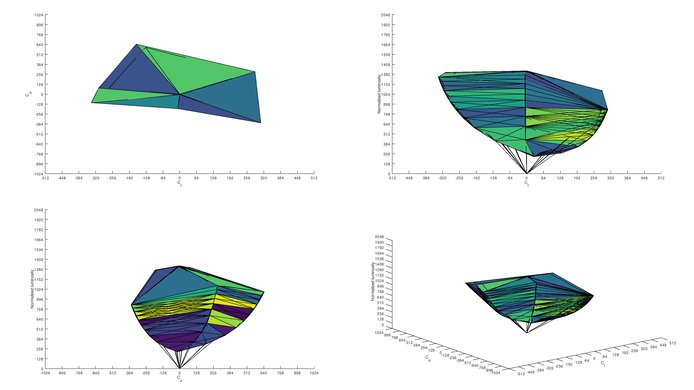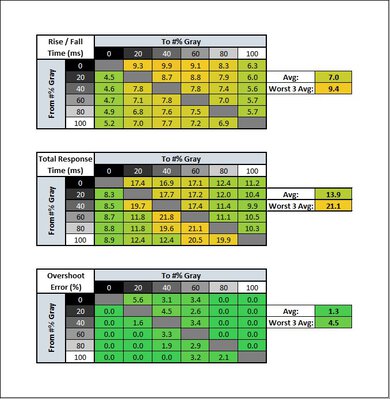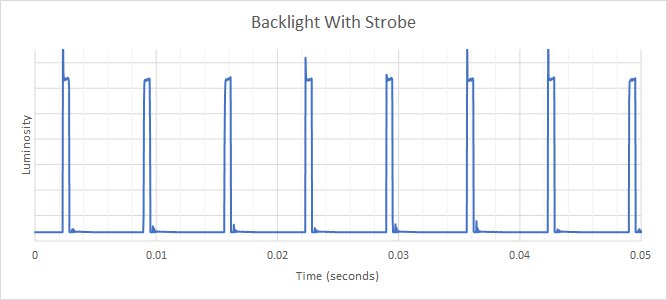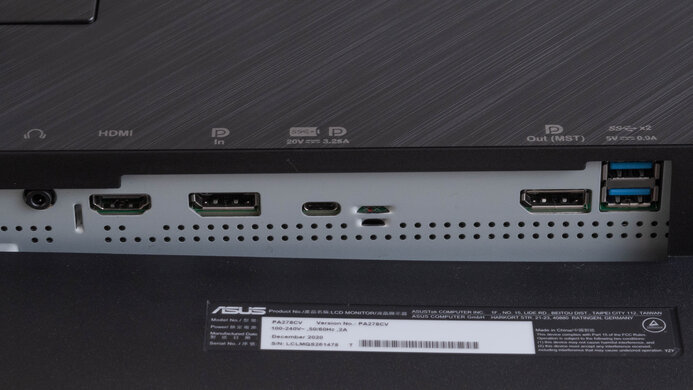The ASUS ProArt Display PA278CV is a low-cost 27-inch, 1440p monitor that's meant for content creation. Part of the ASUS ProArt lineup, it's a newer and more feature-rich version of the ASUS ProArt Display PA278QV, and it sits below the 4k ASUS ProArt Display PA279CV. It competes alongside monitors with similar features, like the Dell U2724D and the BenQ PD2705Q. It comes factory-calibrated and has various picture modes for different color spaces that you may work with, including DCI-P3, but it doesn't support HDR at all. It has useful productivity features, like a USB-C port that supports DisplayPort Alt Mode and 65W of power, and it even supports daisy chaining with a DisplayPort output.
Our Verdict
The ASUS ProArt Display PA278CV is a decent monitor for most usages. It's great for office use as it has sharp text clarity, it gets bright enough to fight glare, and it has a few useful features like a USB-C port and DisplayPort output. It's also good for content creators as it has fantastic accuracy before calibration, but it has more limited coverage of the Adobe RGB color space. While it's decent for media consumption, especially for viewing content in bright rooms, it has limited picture quality in dark rooms due to its low contrast, and the fact that it lacks local dimming. Lastly, it's just okay for gaming as it has a low refresh rate, but it has low input lag for a responsive feel.
- Bright enough to overcome glare.
- Wide viewing angles.
- Remarkable ergonomics.
- Sharp text clarity.
- Extra features like USB-C and DisplayPort output.
- Mediocre contrast ratio.
- Lacks HDR support.
- Some motion blur with fast-moving objects.
The ASUS PA278CV is a great office monitor. It gets bright enough to combat glare in most lighting conditions and has good reflection handling. It also has a ton of ergonomic adjustment options, so you can set it to your ideal viewing position. It has wide viewing angles as well, which is great for sharing content with someone next to you. Lastly, it also has a USB-C port to which you can connect your laptop and charge it with a single cable, and it even has four USB-A ports for other devices.
- Bright enough to overcome glare.
- Wide viewing angles.
- Remarkable ergonomics.
- Sharp text clarity.
- Extra features like USB-C and DisplayPort output.
- Some motion blur with fast-moving objects.
The ASUS PA278CV is okay for gaming. While it has VRR support to reduce screen tearing, it's limited to a 75Hz refresh rate, which is low for most gamers. It also has limited compatibility with consoles as it only supports a few signals with the PS5 and Xbox Series X|S. Luckily, it has low input lag for a responsive feel, and it also has a fairly fast response time, but there's still motion blur with fast-moving objects.
- Supports VRR.
- Low input lag.
- Mediocre contrast ratio.
- Lacks HDR support.
- Some motion blur with fast-moving objects.
The ASUS ProArt Display PA278CV is decent for multimedia. It's a good size for watching movies or videos, and its 1440p resolution delivers a sharp image. It also has wide viewing angles if you want to watch with someone else. Unfortunately, its contrast ratio is mediocre, so blacks look more like gray, especially in the dark. It also lacks HDR support and a local dimming feature.
- Bright enough to overcome glare.
- Fantastic accuracy before calibration.
- Wide viewing angles.
- Mediocre contrast ratio.
- Lacks HDR support.
- No local dimming feature.
The ASUS PA278CV is good for media creation. The 1440p resolution delivers a sharp image, and the 27-inch screen is big enough to place two windows side-by-side. It has an accurate sRGB mode and it displays a wide range of colors, but it has more limited coverage of the Adobe RGB color space. It also has limited picture quality as it has a low contrast ratio, and it lacks a local dimming feature. On the upside, it has wide viewing angles, so the image stays consistent from almost any angle. It also has extra features like a KVM switch and DisplayPort output.
- Bright enough to overcome glare.
- Fantastic accuracy before calibration.
- Wide viewing angles.
- Remarkable ergonomics.
- Extra features like USB-C and DisplayPort output.
- Mediocre contrast ratio.
- Lacks HDR support.
- No local dimming feature.
The ASUS ProArt Display PA278CV Monitor doesn't support HDR.
Changelog
- Updated Jun 04, 2024: Updated text throughout according to current writing standards.
- Updated May 29, 2024: Added that the Dell P2423D has better Text Clarity.
- Updated Dec 05, 2023: Added that the higher-end ASUS ProArt Display PA279CRV supports HDR.
- Updated Apr 18, 2023: Confirmed that 1440p @ 60Hz works on this monitor with the PS5.
Check Price
Differences Between Sizes And Variants
We tested the 27-inch ASUS ProArt Display PA278CV, which is the only size available. It's a newer version of the ASUS ProArt Display PA278QV and has more features, and there are other models in the ProArt lineup that share a similar name. You can see the difference between them below, but the results are only valid for this monitor.
| Model | Size | Resolution | USB-C | DisplayPort Out |
|---|---|---|---|---|
| PA247CV | 24" | 1080p | Yes | Yes |
| PA278QV | 27" | 1440p | No | No |
| PA278CV | 27" | 1440p | Yes | Yes |
| PA279CV | 27" | 4k | Yes | No |
Our unit was manufactured in December 2020. You can see the label here.
Popular Monitor Comparisons
The ASUS ProArt PA278CV is a good low-cost 1440p monitor for content creators, as long as you don't need HDR because it doesn't support it at all. It has an accurate sRGB mode, and it has more useful features than its predecessor, the ASUS ProArt Display PA278QV, like a DisplayPort output and a USB-C port with DisplayPort Alt Mode. That said, it's not versatile as it has limited picture quality and a low refresh rate for gaming, so if you want something more versatile, the Gigabyte M27Q (rev. 2.0) is a good alternative with a higher refresh rate for gaming.
For other options, check out our recommendations for the best office monitors, the best monitors for photo editing, and the best monitors for the MacBook Pro and MacBook Air.
The ASUS ProArt Display PA279CRV is a higher-end monitor than the ASUS ProArt Display PA278CV. The PA279CRV has a higher 4k resolution for better text clarity and also supports HDR, which the PA278CV doesn't. They each have a USB hub, but the PA279CRV delivers higher power delivery than the PA278CV, and it also has Picture-in-Picture and Picture-by-Picture modes.
The ASUS ProArt Display PA278CV is newer than the ASUS ProArt Display PA278QV with more features, and they perform similarly overall. The PA278CV has an added USB-C port that makes it easy to connect your laptop and charge it with a single cable. It also has a DisplayPort outport for daisy chaining a second monitor.
The Dell U2723QE and the ASUS ProArt Display PA278CV are both 27-inch monitors meant for content creation. The Dell has a higher 4k resolution for sharper text, and because it's a higher-end model, it has more features like a bigger USB hub, HDR support, and a KVM switch. On the other hand, the ASUS is the better choice for well-lit rooms as it has much better reflection handling and gets brighter.
The ASUS ProArt Display PA278CV and the Gigabyte M27Q (rev. 2.0) are meant for different purposes. While the Gigabyte is a gaming monitor with a higher refresh rate and faster response time, the ASUS is meant for content creation and multimedia. That said, the Gigabyte has an exceptionally wide color gamut, and it supports HDR, making it well-suited to photo and video editing. If gaming is less important to you, the ASUS is a little more suited to an office setting, as it has more ergonomics adjustment options.

We buy and test more than 30 monitors each year, with units that we buy completely on our own, without any cherry-picked units or samples. We put a lot into each unbiased, straight-to-the-point review, and there's a whole process from purchasing to publishing, involving multiple teams and people. We do more than just use the monitor for a week; we use specialized and custom tools to measure various aspects with objective data-based results. We also consider multiple factors before making any recommendations, including the monitor's cost, its performance against the competition, and whether or not it's easy to find.
Test Results

This monitor has remarkable ergonomics, making it very easy to place in an ideal position. The back of the monitor looks sleek and simple, with a textured finish. There's a clip attached to the back of the stand for cable management.
Though this monitor doesn't have local dimming, we still film these videos so you can compare the backlight performance with a monitor that has local dimming.
The monitor has great brightness in SDR. It's enough to overcome glare in most rooms, and it also stays very consistent across different content. These results are from after calibration in the 'Standard' Picture Mode with Brightness set to max.
This monitor doesn't support HDR. If you want a monitor that does, look into the ASUS ProArt Display PA279CRV.
The horizontal viewing angle is great. The image stays consistent even if you're viewing from the sides, which is great for sharing your screen with someone next to you.
The vertical viewing angle is fantastic, and you won't notice any inconsistencies even when standing up and looking down at the monitor.
This monitor has fantastic accuracy before calibration. The sRGB picture mode locks all colors to the sRGB color space, so there are minimal color inaccuracies, and the white balance is excellent too. The color temperature is nearly spot-on with the 6500K target, and gamma follows the curve fairly well for the most part. The sRGB mode locks most picture settings, including brightness, but other pictures modes are less accurate.
After calibration, the accuracy is incredible. The main advantage of calibrating it is that you can access settings that are locked out in the sRGB mode, like the brightness setting.
The ASUS ProArt PA278CV has an incredible SDR color gamut. It has perfect coverage of the commonly used sRGB color space, but it has limited coverage of the wider Adobe RGB color space used in photo editing with undersaturated greens and oversaturated reds.
Even though this monitor supports a DCI-P3 color space, it doesn't support HDR at all.
The ASUS ProArt Display PA278CV monitor doesn't support HDR.
The ASUS ProArt PA278CV has decent reflection handling. Its matte screen coating diffuses light across the screen well, so glare isn't intense, but it's still not ideal to place opposite a sunny window.
The text clarity is decent. Enabling ClearType (top photo) improves the look of diagonal and curved lines, as you can see in the R, N, G, and S. If you want a monitor with better text clarity, consider the Dell P2423D.
| NVIDIA | VRR Min | VRR Max |
| DisplayPort | 48Hz | 75Hz |
| HDMI | N/A | N/A |
| AMD | VRR Min | VRR Max |
| DisplayPort | 48Hz | 75Hz |
| HDMI | 48Hz | 75Hz |
| Overdrive Setting | Response Time Chart | Response Time Tables | Motion Blur Photo |
| 0 | Chart | Table | Photo |
| 20 | Chart | Table | Photo |
| 40 | Chart | Table | Photo |
| 60 | Chart | Table | Photo |
| 80 | Chart | Table | Photo |
| 100 | Chart | Table | Photo |
This monitor has a good response time at its max refresh rate of 75Hz, with only minimal blur trail behind fast-moving objects. The recommended overdrive setting is '40' because it has the fastest total response time without introducing overshoot.
The ASUS ProArt Display PA278CV Monitor doesn't support 120Hz signals.
| Overdrive Setting | Response Time Chart | Response Time Tables | Motion Blur Photo |
| 0 | Chart | Table | Photo |
| 20 | Chart | Table | Photo |
| 40 | Chart | Table | Photo |
| 60 | Chart | Table | Photo |
| 80 | Chart | Table | Photo |
| 100 | Chart | Table | Photo |
The response time is decent at 60Hz. The recommended overdrive setting is '40,' and even though there's a touch more overshoot than at the max refresh rate, the more aggressive settings have more overshoot, leading to inverse ghosting.
This monitor has an optional backlight strobing feature, commonly known as black frame insertion, to reduce persistence blur. It has two settings, 'Normal' and 'Advanced', and both severely hamper the screen's brightness and cause image duplication because it has bad crosstalk.
This monitor has low input lag for a responsive feel.
The DisplayPort output allows you to daisy chain a second monitor directly to this one, which is great if your computer only has one video output. We couldn't get it to work on ours, but your experience may vary.
The USB-C port delivers enough power to charge most small laptops, and it also allows you to display an image from your laptop with a single cable.



